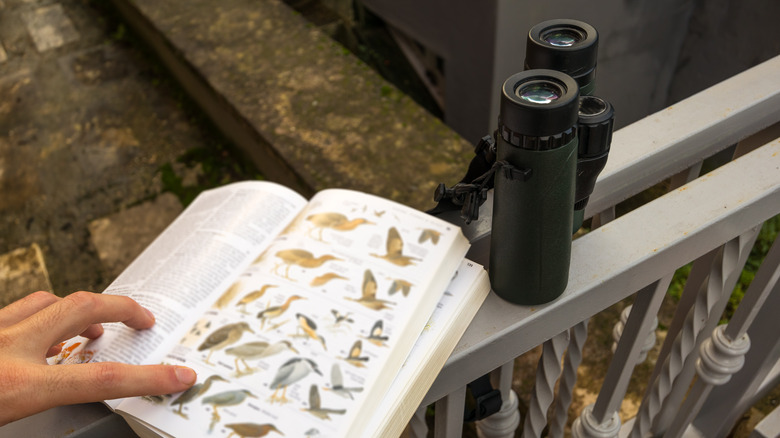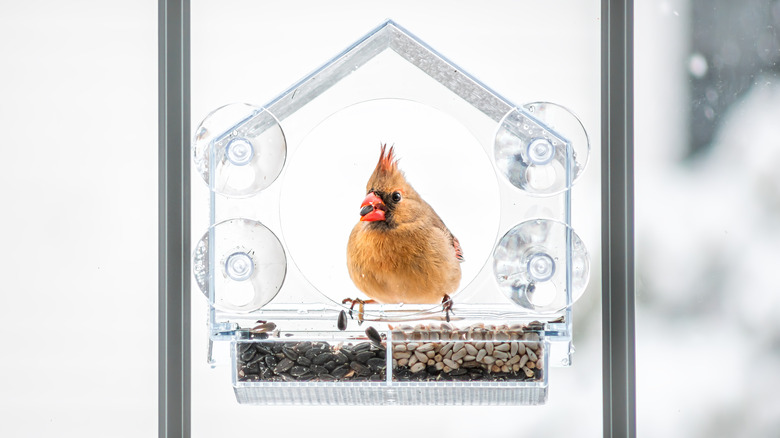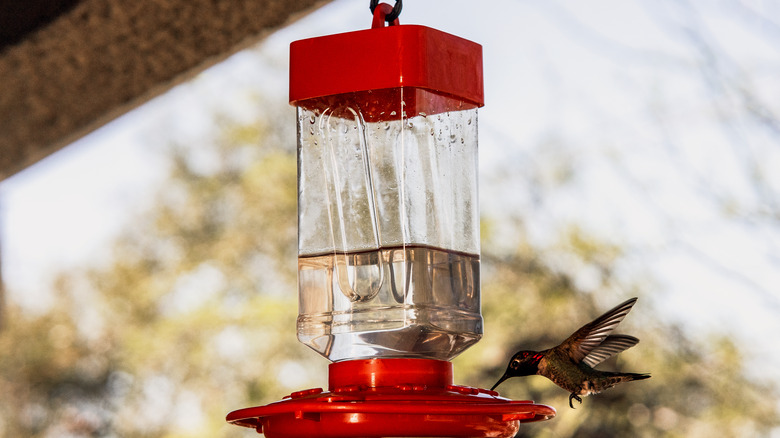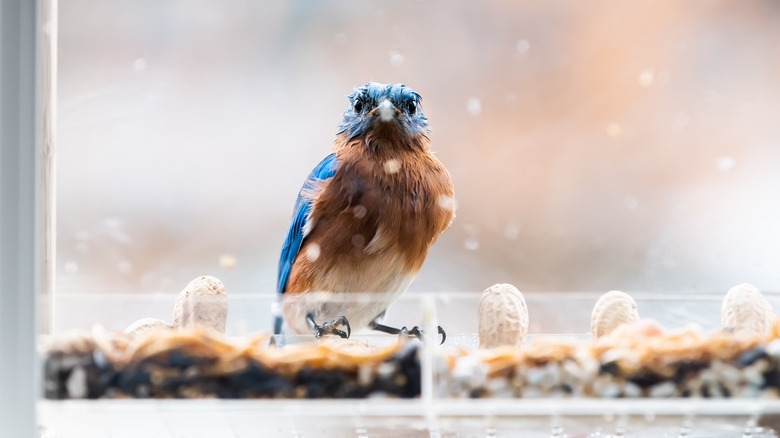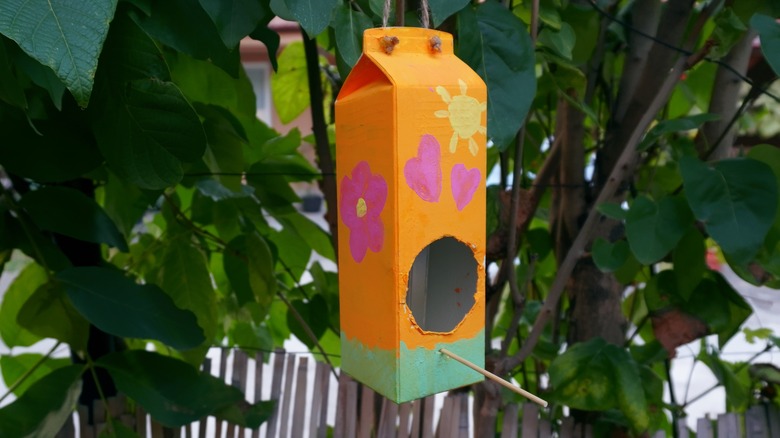4 Simple Ways To Mount A Bird Feeder Outside Your Window
According to the U.S. Fish & Wildlife Service, in 2016, there were 45 million birdwatchers (aka birders), in the United States, with 39 million of them (approximately 87%) being backyard birders. Per National Geographic, this number has only grown in recent years, due in large part to COVID restrictions.
As a result, mounting a bird feeder at your window has become a perfect way to enjoy our feathered companions without stepping outside. Window feeders are a particular boon to those without a yard or garden, or for birders lacking mobility, notes retailer More Birds. You'll be close enough to conveniently identify bird species without spooking them, and a window feeder will be sufficiently accessible to clean, maintain, and replenish the food supply with ease.
Window-mounting methods vary, and some of the basic ones utilize suction cups, hooks, and brackets. Suspending the feeder from a place on the roof near a window is another approach. Choosing the appropriate bird feeder should be influenced by the size and types of birds you hope to see, as well as the logistics of your own viewing perch. An estimated 1 billion birds are killed annually by crashing into windows (via The Condor), so safety rules must be observed when setting up a window feeder. Properly doing so will provide the best viewing conditions while also protecting the birds you're inviting.
What follows are four simple ways to mount a bird feeder outside your window.
1. Suction cup feeder
Feeders equipped with suction cups are the most common style, and they can be used on virtually any size and type of window. Don't skimp on the quality of the cups, and using multiple suction-equipped feeders can add to the viewing experience. Individual suction hooks and brackets are available additions to the simple cups. Incidentally, some feeders operating on the suction principle use Velcro in place of the cups.
A secure bond is critical, and a clean window is imperative. First, clean the grime and dirt from it, and follow up by wiping the surface with rubbing alcohol. BestNest.com recommends bolstering the cups' "stickiness" with a dab of petroleum jelly or cooking oil, and also pressing out any air bubbles that might form. The oil won't evaporate as water would.
It's important to monitor the attachment, so inspect the feeder every time you clean it or refill the bird food. Push in the cups to confirm and strengthen the bond. Nature's Way claims a suction cup window feeder is capable of holding a hefty load of seeds, and can also support a bird as heavy as 4 ounces — the weight of a pileated woodpecker. A wide variety of bird feeders can be mounted successfully using the suction cups.
2. Suspending feeder from roof near window
Rather than sticking a bird feeder directly onto a window, it can be suspended from a mounting on the roof and lowered in front of the glass. According to Wild About Birds, this method will succeed with almost any kind of lightweight bird feeder, and the suspension technique works well with a tube-style feeder or one for hummingbirds.
Per Thayer Birding, to set this up, first drill a hole in the roof's overhang and tightly screw in the hook or bracket that will be anchoring the feeder. Attach a strong wire or chain to it and lower the device to the chosen level in front of the window pane, being sure to observe what World Birds calls the 5-7-9 rule to defy squirrels: The rodent won't jump 5 feet up, or 7 feet across an access point, or will avoid a 9-foot drop to ambush the birds from above.
This style of window bird feeder will swing in the wind, so as short a leash as possible works best for the life of your window. Make sure to steer clear of a window air conditioner, and as is the case with any type of feeder, it's wise to periodically check the hardware and connections.
3. Solarium window feeder
The so-called solarium feeder is one that rests on the windowsill. The window either closes on it to secure it, or the feeder can be anchored outside. The window you choose should not be in a busy area of the house as the hustle and bustle will startle the birds. It also shouldn't be situated above a deck or patio to avoid frequent cleaning and keep users from being bombed with seeds and droppings. And that's a general rule: If possible, don't mount a window feeder where the mess will be very visible below it.
Two other caveats according to More Birds: One, if you mount a feeder in the solarium fashion, it cannot be locked or armed with an alarm, and two, this type of feeder is not a viable option for a hinged casement window that would open outward. One advantage of the solarium feeder is that it's able to hold at least a quart of seeds — generous for the birds and requiring less frequent refills. Also, such a feeder is easy to reach, making the cleaning and stocking it a cinch. A solarium feeder with a large platform will be adequate for larger birds, and should they be welcome, squirrels will stop by too, suggests Birds and Blooms.
4. DIY window mounted feeders
You can even attract hungry birds to your window by hanging a milk carton feeder in front of the window, according to Teach Beside Me. For this DIY bird feeder, empty and wash out a half-gallon carton. Next, make it a see-through feeder by removing the opposing ends. After cutting a hole through the carton's top, the makeshift bird feeder can be hung in front of a window using a hook and twine set-up attached to a suction cup. This feeder will be efficient but require periodic replacement.
Screwing or nailing feeding trays directly into the window frame or sill is another mounting idea. Like the solarium variation, this will be suitable for larger birds, and can be filled with a large amount of seeds. A simple board nailed to the sill will work as a bird feeder as well. A large offering of sunflower seeds will attract the flyers to this DIY feeder.
Birds will reduce their speed to land on a window feeder, which is helpful in avoiding collisions. Regardless of the mounting method used for a window feeder, it's a good idea to apply soap to the glass, or stick decals or tape to it, to further protect your avian visitors, per Bird Gap. Also, be sure cats or other predators don't have access to the feeder, and also provide an ample water supply. Keep the feeder clean and well-supplied with seeds, suet cakes, and other bird goodies.
